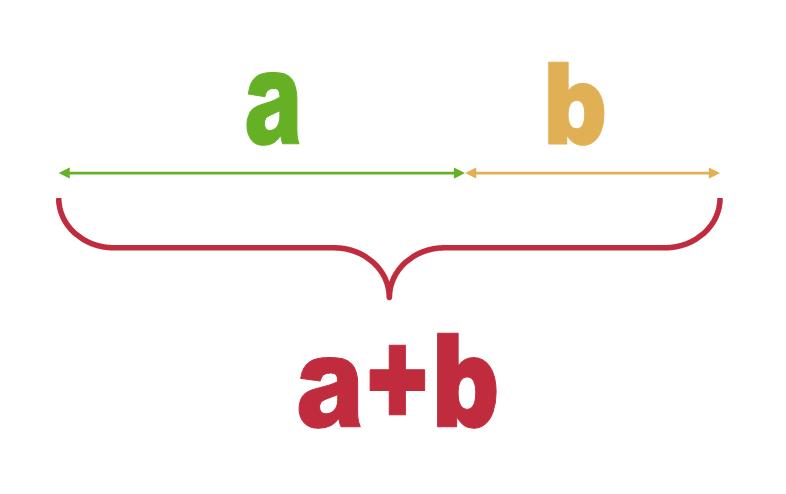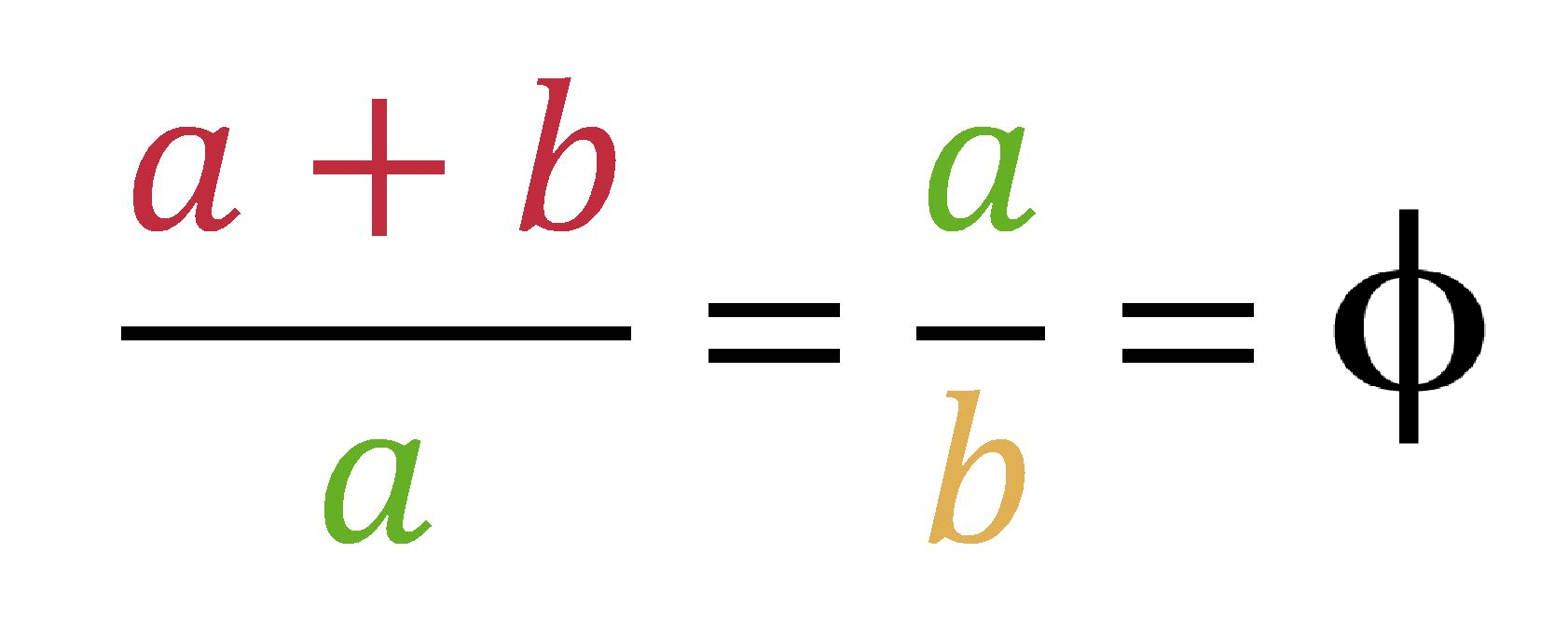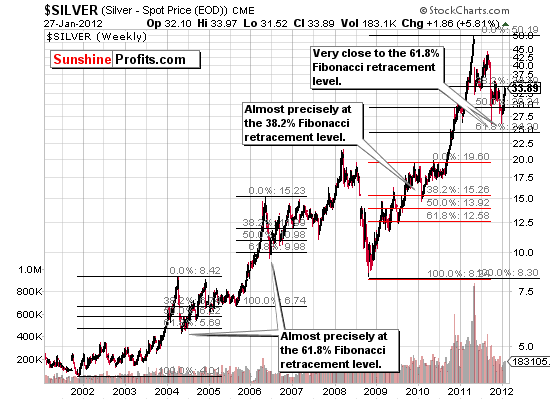| |
Eric asks:Eric wants to purchase a new painting for his living room. He asked Jill and John to help him pick the right one. Jill and Eric are browsing some Internet gallery. Read the whole discussion Derivation of PhiPhi can be obtained in various ways. It was first derived geometrically through the so-called golden ratio or golden section: a line segment is divided into two segments in such a way that the ratio of the longer one to the shorter one is equal to the ratio of the whole segment to the longer one obtained after the division. Below we can see this idea illustrated graphically:

The equality of ratios says that: 
Another way of deriving phi is through solving a quadratic equation: 
The solutions are: 
Yet another way of obtaining phi is through the Fibonacci sequence which is the following sequence of natural numbers: 1, 1, 2, 3, 5, 8, 13, 21, 34, 55, 89, 144, 233, 377, 610, ? In other words, each term (starting from the third) is a sum of the two preceding ones: 1+1=2, 1+2=3, 2+3=5, 3+5=8 and so on. Phi is the limit of the ratio of an element of the sequence to its predecessor. This means that it approaches phi (approx. 1.618) as we proceed to infinity (the convergence begins to take shape after a couple of elements: 1/1=1, 2/1=2, 3/2=1.5, 5/3=1.667, 8/5=1.6, 13/8=1.625, 21/13=1,615, 34/21=1.619, 55/34=1.618, and so on). Properties of phiPhi has myriad interesting mathematical properties. The most popular are presented below: - Right from the equation
 (whose solution ? as has already been stated above ? is phi) we get that (whose solution ? as has already been stated above ? is phi) we get that (phi = 1.618, phi^2 =2.618) (phi = 1.618, phi^2 =2.618)   - Phi and its inverse have exactly the same decimal part: ?=1.618033988749894848204586834365.... 1 =0.618033988749894848204586834365....
- Moreover, if n is odd then
 and and  have exactly the same decimal parts. The table below provides an illustration of this fact for n from 1 to 7: have exactly the same decimal parts. The table below provides an illustration of this fact for n from 1 to 7:
| n | phin | 1/ phin |
|---|
| 1 | phi1 = 1.61803398875 | 1/phi1 = 0.61803398875 | | 2 | phi2 = 2.61803398875 | 1/phi2 = 0.38196601125 | | 3 | phi3 = 4.23606797750 | 1/phi3 = 0.23606797750 | | 4 | phi4 = 6.85410196625 | 1/phi4 = 0.14589803375 | | 5 | phi5 = 11.09016994375 | 1/phi5 = 0.09016994375 | | 6 | phi6 = 17.94427191000 | 1/phi6 = 0.05572809000 | | 7 | phi7 = 29.03444185375 | 1/phi7 = 0.03444185375 |
The occurrence of phi in the worldThe golden ratio is present in so many areas that it is hard to list them all. Below there are just some examples. Phi is omnipresent in the proportions of human body, for instance the distance from the head to the fingertips is approximately the golden section of the height of the body, and the distance from the top of the head to the chin is approximately the golden section of the distance from the head to the chest. Many scientists believe that it plays an important role in the human perception of beauty. In nature it can be seen in the shape of some seashells and the arrangement of leafs of some plants. It also appears in the human art ? the most famous example is Leonardo da Vinci's Mona Lisa whose face is a perfect golden rectangle, that is the ratio of her face's height to its width is 1.618. But other renowned painters such as Salvador Dali (e.g. the dimensions of his painting ? Sacrament of the Last Supper ? are in a golden ratio to each other) also used the golden section to achieve geometrical beauty. Golden section can be found in architecture as well. Examples include the proportions of such marvelous buildings as the Parthenon or the Chartres and the Notre Dame cathedrals. It continues to show up in the contemporary architecture, for instance in the proportions of the United Nations building or the CN Tower in Toronto. Applications of phi in the financial marketsBelow there are two examples of the use of phi in the financial markets: - Fibonacci retracement levels - the inverse of phi (approx. 0.618 or 61.8%) and its square (approx. 0.382 or 38.2%) are used as important retracement levels, i.e. levels that serve as support or resistance as the price retraces some of its previous movement in a trend. For instance, in an uptrend, after reaching a local top, price is likely to retrace between 38.2% and 61.8% of the distance from the last bottom to this top. The name corresponds to the way of obtaining phi by means of the Fibonacci sequence.
- Elliott wave theory - Phi is used in Elliot wave theory to set price targets for particular parts of a trend. For instance, it is assumed that an uptrend is formed of five ?waves?: waves number 1, 3 and 5 represent moves up, while waves number 2 and 4 represent corrections in the main trend. To find the price target for the third wave one multiplies the length of the first wave by phi (approx. 1.618) and adds that to the bottom of wave 2. The price target for the fifth wave can be obtained by multiplying the length of the first wave by 2 times phi (approx. 2*1.618 = 3.236) and adding it to either the top or the bottom of the first wave to obtain maximum and minimum targets.
Phi and the precious metals marketThe chart below (courtesy of http://stockcharts.com/) presents an example of the use of Fibonacci retracement levels to find support levels on the silver market. 
The support levels obtained through the use of phi proved accurate in the analysis of silver price movements. ConclusionPhi and the idea behind it (the golden section) is an ubiquitous phenomenon in the world around us and in the society, even though we may not realize its existence. It is then no surprise that it also appears in the financial markets. It should be noted though, that in the technical analysis, various transformations are used much more frequently that the phi number (1.618) itself, for example its inverse (0.618) and its inverse square (0.382) to construct Fibonacci retracement levels.
http://www.sunshineprofits.com/research/multimedia2/../articles/phi-number/ |

